In a groundbreaking study that marries the realms of artificial intelligence and environmental conservation, researchers are harnessing the power of long short-term memory (LSTM) neural networks to predict changes in mangrove ecosystems in blue forest conservation projects. This innovative approach signals a new era in ecological forecasting, offering a deep dive into how technology can aid the preservation of vital coastal environments. The study, undertaken by Farzanmanesh, Khoshelham, and Volkova, explores not only the methodologies but also the implications of accurately forecasting mangrove health and distribution in response to various environmental pressures.
The unique architecture of LSTM networks offers an edge in forecasting due to their ability to learn from sequences of data. Unlike traditional neural networks, which often struggle to retain information from past inputs, LSTM networks can remember previous inputs for extended periods. This is particularly crucial in environmental sciences, where temporal dependencies play a significant role in understanding ecological dynamics. By applying this technology to mangrove ecosystems, the authors are setting a precedent for utilizing machine learning in the conservation field.
Mangroves, often dubbed the “mangrove guardians,” are integral to coastal systems. They provide numerous ecosystem services, from carbon sequestration to serving as nurseries for marine life. However, these critical ecosystems face threats from climate change, urban development, and pollution. The innovative use of LSTM networks to forecast changes in these habitats could be a game-changer for conservationists striving to protect these vital resources.
The study presents a detailed examination of two conservation projects focused on blue forests, which are significant not just for their biodiversity but also for their contributions to mitigating climate change. By integrating real-time environmental data with LSTM models, the researchers can assess how various factors, including sea level rise and temperature fluctuations, influence mangrove health. This predictive capability allows for proactive management strategies, enabling conservationists to implement measures before adverse conditions lead to irreversible damage.
Data collection is a cornerstone of this research. The team has employed remote sensing technologies and extensive field surveys to gather comprehensive datasets. These datasets encompass various environmental indicators, providing a rich foundation for training the LSTM models. The integration of high-resolution imagery and real-time ecological data allows for nuanced modeling of mangrove changes over time, increasing the accuracy of predictions.
Moreover, the LSTM model’s capacity to process large volumes of data is matched by its ability to continuously improve. As it ingests more data over time, the model learns from past patterns, refining its forecasts. This dynamic adaptability is essential in the face of an ever-changing climate, where historical data alone may not suffice to predict future scenarios accurately. Consequently, the researchers argue that such models can significantly enhance our understanding of ecological resilience and vulnerability.
The implications of this research extend beyond just forecasting; they encompass a broader vision for how conservation efforts can be shaped. With accurate predictions, stakeholders can allocate resources more effectively, prioritizing areas that are at greatest risk. This proactive approach stands in sharp contrast to traditional reactive measures, which often come into play only after environmental degradation has already occurred.
Encouragingly, the research team highlights that their findings could pave the way for similar applications in other types of ecosystems facing anthropogenic pressures. The LSTM approach can be adapted to forecast changes in various environments, including forests affected by deforestation or wetlands struggling under rising pollution levels. As the world grapples with increasing environmental challenges, such adaptable technologies will be invaluable.
In addition to technical advancements, this research emphasizes the importance of interdisciplinary collaboration. By bringing together expertise from environmental science, data science, and machine learning, the study showcases how diverse fields can create innovative solutions to pressing global issues. The success of such collaborations signals a need for enhanced education and training that merges these disciplines, equipping future generations to tackle ecological crises head-on.
The findings also have significant policy implications. Policymakers can leverage these forecasts to inform legislation aimed at protecting mangrove habitats and other critical ecosystems. By relying on data-driven insights rather than anecdotal evidence, decision-makers can create more effective environmental policies that address the root causes of habitat degradation. As a result, integrating advanced forecasting methodologies into policy frameworks can lead to more sustainable management of natural resources.
The ethical dimensions of using AI in environmental conservation cannot be overlooked. As machine learning technologies become more prevalent, ethical considerations surrounding data privacy, algorithmic bias, and decision-making processes must take center stage. Researchers advocate for transparency in how LSTM models are developed and applied, ensuring that conservation efforts do not inadvertently disadvantage marginalized communities or disrupt existing socio-ecological systems.
In conclusion, the pioneering study by Farzanmanesh, Khoshelham, and Volkova represents a watershed moment in the intersection of artificial intelligence and environmental conservation. By employing LSTM neural networks to forecast mangrove changes, the researchers not only illuminate the potential of technology to enhance ecological understanding but also inspire a broader movement toward innovative solutions in environmental management. As the impacts of climate change continue to escalate, embracing such forward-thinking methodologies will be crucial in safeguarding our planet’s vital ecosystems for future generations.
In an age where ecological predictions are more critical than ever, the study reinforces the notion that technology can and should play an instrumental role in environmental conservation efforts. As scientists delve further into the capabilities of machine learning and artificial intelligence, we can only anticipate exciting advancements that will further bridge the gap between research and real-world ecological stability.
Subject of Research: Mangrove ecosystem change forecasting using LSTM neural networks
Article Title: Using a long short-term memory neural network model to forecast mangrove change in two blue forests conservation projects
Article References: Farzanmanesh, R., Khoshelham, K., Volkova, L. et al. Using a long short-term memory neural network model to forecast mangrove change in two blue forests conservation projects. Discov. For. 1, 10 (2025). https://doi.org/10.1007/s44415-025-00009-0
Image Credits: AI Generated
DOI:
Keywords:




